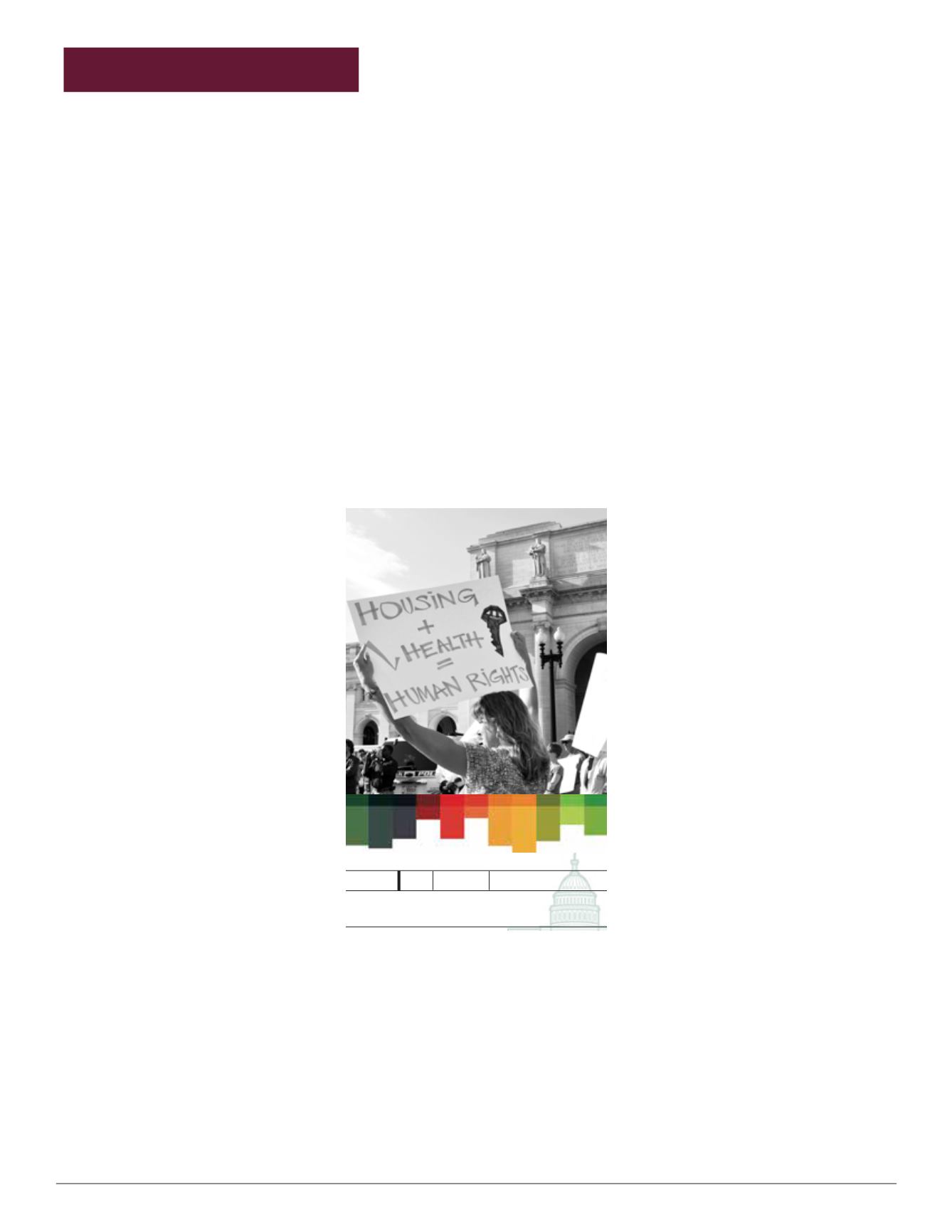
14
COM Outlook . Fall 2013
Project HOPE:
Where Hope Is More Than an Aspiration
roject HOPE (Homelessness in
Osteopathic Predoctoral Education)
began within the College of Osteo-
pathic Medicine as a primary care initia-
tive in 2010. The project was developed to
educate osteopathic medical students on the
unique primary care needs related to those
experiencing instability in housing. In ad-
dition to evaluating change in attitudes and
knowledge based upon didactic curricula
and direct experience, the project seeks to
disseminate curricula, research, and lessons
learned on a national level.
Now in its third year, the project has
gained attention through both international
and national presentations and through the
support of the only academic affiliation with
the National Health Care for the Homeless
Council. Nadine Chipon-Schoepp, D.O.,
assistant professor of family medicine, was
recently named as a subject matter expert
with the council. The project presented
three oral presentations at the council’s 2013
symposium. In addition, a survey of homeless
health curricula within allopathic and osteo-
pathic medical schools, which was completed
by OMS-IV students Andrew Garrett, Britta
Gray, and Samantha Berr, was showcased,
winning the symposium’s Best Poster award.
The curricular model that has been
developed at NSU-COM has been lauded as
an innovative model that can be replicated
at other osteopathic and allopathic medi-
cal schools to focus on any vulnerable or
special population. Currently, the University
of Southern California, De Sales, and the
University of South Florida have expressed
interest in modeling the program for physi-
cian assistant and dentistry programs.
As a model that is collaborative and
integrated by design, curricular plan and
P
project advances are facilitated through
focus groups with students, faculty mem-
bers, clinicians, and—most importantly—
through the direct involvement of homeless
health care consumers. Additionally, faculty
and staff members represent Project HOPE
in the community through membership and
participation on local affordable housing
boards, Broward County’s Health Care for
the Homeless Consumer Advisory Board,
and with the National Health Care for the
Homeless Education Committee.
The culmination of these efforts is
reflected through 27 curricular hours that
are truly integrated across all years of medi-
cal school. Additionally, agreements with
Health Care for the Homeless centers across
the county are being positioned such that
students working in these clinics will have
the most interaction with those experienc-
THE SAFETY NET
MAKES US
STRONGER
3/15/13
INFRONTOF
UNIONSTATION
5:30–
6:30
P
.
M
.
MEET INTHEHYATTHOTELLOBBYAT5:15
P
.
M
.
ANDWALKTOGETHERTOUNIONSTATION
date
location
time
RALLY FOR HUMAN RIGHTS
details
Speakers include the National Health Care for the Homeless Council’s
Executive Director, John Lozier, President of the Board, Bobby Watts, and more!
ALL WELCOME. BRING SIGNS.
SPEAK OUT.
ing homelessness. In addition, agreements
are in place with Camillus Health Concern
in Miami and with Orange Blossom Health
Care for the Homeless in Orlando.
In an effort to best equip all medical stu-
dents, housing intake forms became a require-
ment of all monthly rotation logs to both em-
phasize that those experiencing instability in
housing do not solely present at Health Care
for the Homeless centers, and that housing
status is irrefutably connected to a competent
patient-care plan. This was launched within
rural/underserved rotations in March 2012
and in July 2012 for other rotations.
Accordingly, all medical students’ expe-
riences in primary health care delivery to
the homeless will continue to be expanded.
Data from 2,284 recently completed logs
revealed a 6.9 percent encounter rate, with
individuals experiencing homelessness
across all rotations with an average of 11
patients encountered per student. As Med-
icaid expansion ensues, it is critical that
medical students are competently trained
with a skill set conducive to working with
a diverse population inclusive of diverse
needs. While populations may be consid-
ered
special
or vulnerable, they still reside
within the general population. Accordingly,
medical education programs must integrate
rather than silo such underserved groups.
While project insights and data are
revealing, they cannot articulate the
humanistic qualities and attributes that are
nurtured through our students’ experiences
with those less fortunate within our society.
Aligned to the values and mission of NSU-
COM, Project HOPE is a leader amongst
medical education programs dedicated to
the vulnerable and underserved through
innovation and dedication.
HOMELESSNESS PROJECT
By Elliot Montgomery Sklar, Ph.D., M.Sc., Project HOPE Director, and
Kristi Messer, M.S.W., M.P.H., Project HOPE Executive Director


